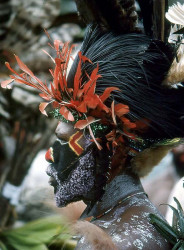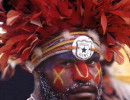Huli Wigmen
-
37 feather and flower head dress in the southern highlands

-
2 Caterpillar Lip 800

-
6 Big Red The Headhunter 800
-
12 Head Dress Made of Animal Fur and a Kina Shell around his Neck 800
-
21 Warrior along the trail carrying a handful of spears 800
-
18 Got his Feathers All Ruffed Up 800
-
34 Special Agent in the Highlands 800
-
70 Coming upon a Huli Wigman on the trail 800
-
102 Bird Wing Ears 800
-
104. Painted Huli Wigman Warrior 800
-
106 Young black faced warrior 800
Huli Wigmen
The Huli are an indigenous Melanesian ethnic group who reside in Papua New Guinea. They speak mainly Huli and Tok Pisin; many also speak some of the 839 living languages of PNG, and some also speak English. They are one of the largest cultural groups in the country, numbering over 250,000 people at the time of the 2011 national census.
Unlike many other PNG's Highlanders, the Huli have not relinquished much of their culture to the ways of the colonizers and outsiders who settled to live among them in 1951.
The Huli live in the Tagari River basin and on the slopes of the surrounding mountain ranges at an altitude of about 1,600 meters above sea level in a land of perpetual Spring where it rains seven out of ten days and the temperature ranges from eighty degrees F. during the day to forty-five F. during the night.
The Huli landscape consists of patches of primary forests, reed-covered marshes, kunai grasslands, scrub brush, and mounded gardens alongside rivers, small streams, and man-made ditches that serve as drainage canals, boundary markers, walking paths, and defensive fortifications.
The colorful Huli Wigmen are reputed to be one of the few remaining headhunter populations on Earth. Although conversations were rare with the tribal warriors I met, occasionally their hand gestures mimicked removing one's head. These gestures weren't threatening, but more of a humourous nature.






























